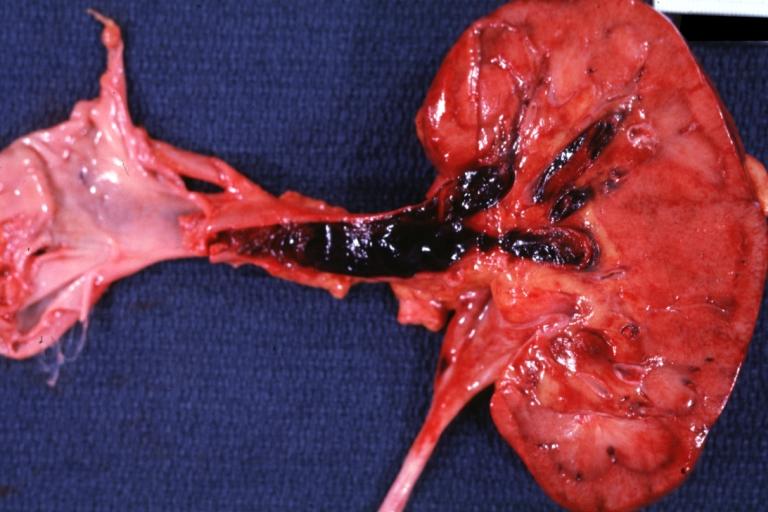Renal vein thrombosis
For patient information page, click here
| Renal vein thrombosis | |
 | |
|---|---|
| Transplant with Renal Vein Thrombosis: Gross; natural color, opened kidney and vein. Image courtesy of Professor Peter Anderson DVM PhD and published with permission © PEIR, University of Alabama at Birmingham, Department of Pathology | |
| ICD-10 | I82.3 |
| ICD-9 | 453.3 |
| DiseasesDB | 11359 |
| MedlinePlus | 000513 |
| eMedicine | med/2005 radio/887 |
Template:Search infobox Editor-In-Chief: C. Michael Gibson, M.S., M.D. [1]
Please Take Over This Page and Apply to be Editor-In-Chief for this topic: There can be one or more than one Editor-In-Chief. You may also apply to be an Associate Editor-In-Chief of one of the subtopics below. Please mail us [2] to indicate your interest in serving either as an Editor-In-Chief of the entire topic or as an Associate Editor-In-Chief for a subtopic. Please be sure to attach your CV and or biographical sketch.
Overview
Renal vein thrombosis (RVT) is the formation of a clot or thrombus obstructing the renal vein.
Epidemiology
Among patients with nephrotic syndrome, the incidence of real vein thrombosis is quite variable. Some reports place the incidence at 5% while others place it at 62%.
Pathophysiology
A hypercoagulable state or mechanical compression of the renal vein is often present in those patients with renal vein thrombosis. This can be due to malignancy or it can be due to the nephrotic syndrome. In nephrotic syndrome there is an excessive urinary protein loss which is in turn associated with decreased antithrombin III. It is unclear why the renal vein is susceptible to thrombosis in patients with nephrotic syndrome.
Complete Differential Diagnosis of Causes of Renal Vein Thrombosis
Common Causes
- Nephritic syndrome (defined as >3 g/d protein loss in the urine, hypoalbuminemia, hypercholesterolemia, and edema)
Uncommon Causes
- Antiphospholipid antibody syndrome
- Behçet's syndrome
- Hypercoagulable states
- Kidney transplant
- Renal cell carcinoma [1] [2]
Symptoms
Back or flank pain may be present. Hematuria may be present.
Diagnosis
CT angiography can be used in diagnosis.[3]
Treatment
Surgery to remove the clot is possible, but rarely performed.
Anticoagulation therapy can have some benefits.[4]
See also
References
- ↑ Sailer, Christian, Wasner, Susanne. Differential Diagnosis Pocket. Hermosa Beach, CA: Borm Bruckmeir Publishing LLC, 2002:77 ISBN 1591032016
- ↑ Kahan, Scott, Smith, Ellen G. In A Page: Signs and Symptoms. Malden, Massachusetts: Blackwell Publishing, 2004:68 ISBN 140510368X
- ↑ Asghar M, Ahmed K, Shah SS, Siddique MK, Dasgupta P, Khan MS (2007). "Renal vein thrombosis". European journal of vascular and endovascular surgery : the official journal of the European Society for Vascular Surgery. 34 (2): 217–23. doi:10.1016/j.ejvs.2007.02.017. PMID 17543556.
- ↑ Zigman A, Yazbeck S, Emil S, Nguyen L (2000). "Renal vein thrombosis: a 10-year review". J. Pediatr. Surg. 35 (11): 1540–2. doi:10.1053/jpsu.2000.18302. PMID 11083418.
External links
- Overview at Merck Manual
- Diagnosis at wustl.edu